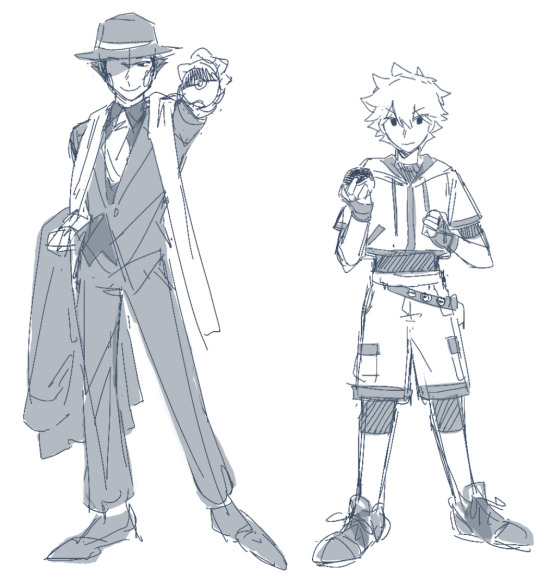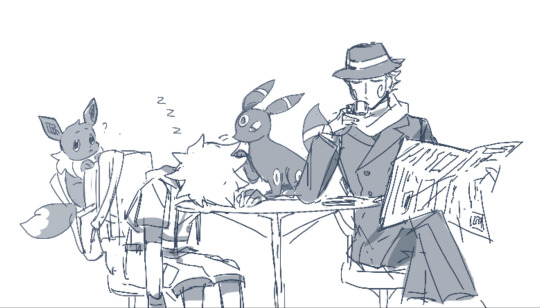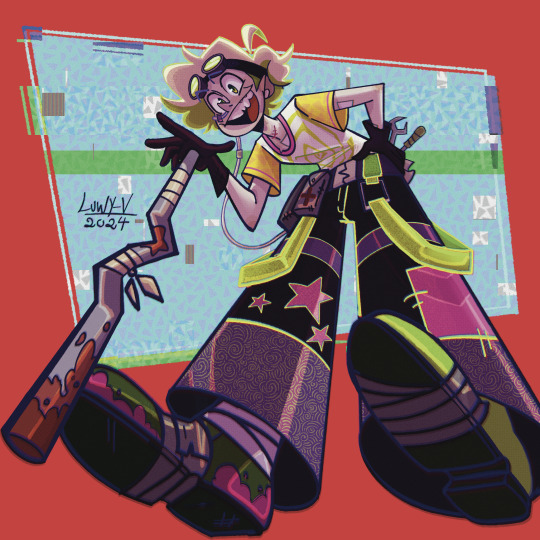#ow lore
Explore tagged Tumblr posts
Text
the urge to do a rewrite + redesign of all of overwatch's lore and make a full story and comic out of it grows stronger by the day
19 notes
·
View notes
Text
I think some of y'all forgot that there are currently Overwatch agents in jail still. If Talon being in jail wasn't enough, there are still a few people in Overwatch serving out their sentences because of the Petras Act.
One can only assume they either stayed there, left, or broke out some how, the theory is up to you. But you have to mind the people who aren't on the outside. It's been twelve years nearly. I can't imagine how disconnected some will feel from the world if they leave.
15 notes
·
View notes
Text

"But maybe I can tell you now? Actually, I wanted to be with you, too. I wanted to escape with all of you..." "Yes. So do I."
Drew one of my favorite HetaOni scenes because the rest of the game reveal left me with a lot of feelings about it 🥲
#hetalia#hetaoni#hws japan#aph japan#kiku honda#hws italy#aph italy#hws north italy#hws italy veneziano#feliciano vargas#itapan#ish? not particularly romantic but i Do like itapan#myart#i love this scene a lot.... italy finally admitting that for all his willingness to sacrifice himself for the others' sake#what he really truly wants is to be by their side and escape with them... and japan+the others' reassurance that it's what they want too 🥺#hetaoni is about many things but despite all the loss and tragedy and suffering. at its core it's about hope and friendship and love. to me#also their exchange that leads up to this where japan's like 'you mean *everyone* right? surely you're including yourself in that??'#and italy's just 'ummm... well....' is so. ow.#this is kinda wonky in places and not really polished but it's Fine#i just needed a way to get my feelings out bc i have more emotions than i know what to do with right now 😭#hetaoni still finding new exciting ways to deal emotional damage in the year of our lord 2025.....#i say that like i wasn't already having hetaoni feelings before that over the weekend. the lore reveal just made them worse 😭😭
219 notes
·
View notes
Note
Hear me out... We got Yandere Burning spice...what about Yandere Herald of Change

Oh God... That would be so horrible lol. If we're working with the Herald of Change from the time travel AU, theeeeeeeen he would have to be closer to corruption than he is in the actual story (Golden Cheese is transported to a time where Burning Spice was still a genuine good guy). Yandere Herald would be different from Yandere Beast in that he wants to have Golden Cheese to himself forever, but is more... discreet about it. He tries harder to pretend to be normal, because he's actually aware that he'd drive her away if he didn't. But his mask would start slipping with time, because Golden Cheese wants to go home and he doesn't want that. He wants her to stay. He doesn't actually know or understand where her home is (Time Travel AU Spice doesn't know she came from the future, only that she's lost), but does it really matter? Why can't she make a new home here with him? Why can't she stay with him? She should stay with him. He'll convince her to stay with him. She'll understand and agree. And if she doesn't? If she doesn't... No, of course she will. Won't she? Why wouldn't she? That kingdom she's mentioned? Those people? They don't need her like he does. He's sure they're doing ok without her. Worse comes to worst, they can make a new kingdom together. That's his job, after all: to build and nurture civilizations. They can have one of their own, they can be king and queen. They can be happy. She can be happy. She just has to stay. She has to stay. She has to stay. She has to stay.
If she still doesn't want to stay...?
Fine. It's fine. He'll make her stay.
#ok no more Herald talk. gotta wait for the first chapter of the AU to drop#i was supposed to have finished it last weekend but things got and continue to get in my way... hopefully THIS weekend is the one#(I owe my artist friend several bouquets of flowers in apology at this point lol)#Herald doesn't know GC is from the future. there's your one little lore crumb pre-story launch#whether or not he ever finds out is... for me to know and for you to find out eventually haha#but yeah Yandere Herald would be a bit like Eternal Sugar in his behavior/mindset i think#but start falling into Yandere Spice behavior if he feels like she's slipping away#also Yandere Spice and Yandere Herald would fight each other to the death over her lol#cookie run kingdom#burningcheese#goldenspice#cookie run au#might as well tag that ig#merchant asks#also none of this is canon just making that clear haha#Herald is a good guy his crush/love is healthy and genuine. worst thing he is is just persistent haha
143 notes
·
View notes
Text
Also if I'm gonna talk about the leaked interactions then I might as well say...
Reaper76 divorce era having some sign of being over was not on my 2025 bingo card
#overwatch#overwatch 2#overwatch lore#overwatch headcanons#overwatch reaper#reaper ow#reaper overwatch#reaper76#r76#gabe reyes#gabriel reyes#jack morrison#soldier 76 overwatch#solider 76#overwatch soldier 76
89 notes
·
View notes
Text


Pokemon trainer AU, Reborn is the champion meanwhile Tsuna is his apprentice. Tsuna’s design belongs to my friend @Cloud_Knee (Twt or X)
#katekyo hitman reborn#r27#sawada tsunayoshi#reborn#my friend and i discussed about which pokemon would be in their team. eevee and umbreon was ther for their similar looks to r27 lol#flygon is a good candidate bc yk. leon. and for tsuna suprisingly we liked the idea of meloetta (bc meloetta has two forms like how tsuna-#-has his normal vibe and his dying will mode)#for reborn we thought of him having a liking for bug types bc of his bug communication skills. like his seasonal bug thing#we also thought of lore for a whole game which was heavily based on pokemon mystery dungeon bc we wanted death (future arc spoilers oof)#but general beginning plot is: tsuna dislikes having pokemon battles so all his pokemons are non-combat#- somehow he meets reborn (? idk maybe bro trips and got silly and he now owes reborn something). and reborn then seeing how close-minded-#tsuna is he decided to accept tsuna as his apprentice so he finally gets it#we discussed about tsuna also seeing reborn often at a lot of places but never got in contact (bc we thought of him living on a mountain idk#like how everyone cant see through reborn’s disguises but he can. so he’ll just see him around (bc reborn is hiding himself from the public)#as a champion. yeah#yeah thats about it i think. ive forgotten most of our ideas dkdgkgfhfhfj maybe another time
685 notes
·
View notes
Text

Besties!!
#my art#doodles#homicidal porkchops#homicidalporkchops#chance fanart#forsaken chance#chance forsaken#itrapped fanart#itrapped forsaken#forsaken fanart#forsaken roblox#roblox forsaken#roblox art#chance is such a sweetheart he didn't deserve this#PLEASE keep itrapped in his new lore or else it'll be super lame#i really hope it's not “I lost a bet and now I owe the mafia 7 million dollars! Whoopsie!”#i could yap about this for hours
44 notes
·
View notes
Note
Can you draw dat new NPC Null plz! -PartyNoob Anon🎉

Floor 137: Shop Space
shadow of the sun
#regret-delivery#mod melon 🍈#postal-vator#regretevator null#regretevator mr#im not really caught up on the lore... is this. anything???#also OW this ask is old sorry 😓
67 notes
·
View notes
Text






Some stuff from my sketchbook :3
#if u ask about my oc lore i will owe u my life#furry#furry fandom#furry art#furry artist#gay furry#queer furry#lgbt furry#nonbinary furry#trans furry#furry community#fursona#anthro#anthro art#lion furry#wolf furry#dog furry#hybrid furry#fox furry#sketch#sketches#sketchbook#pen sketch#my art#mine
97 notes
·
View notes
Text
shoutout to whatever L and Light had going on in Time Speaks
#and they had A LOT going on#death note#l lawliet#light yagami#death note fanfiction#lawlight#been thinking about rereading it. overwhelmed with emotion simply at the thought#god that fic is so. so.....#if you've read the fic please....... please talk to me#it's a time loop fic it's a fix-it fic it's got angst it's got lore it's got good misa writing it's got domesticity it's got mind games#it has everything like EVERYTHINGGG#I've never been so engaged with death note lore before#the world building is crazy the build-up to the reveal is crazy#almost every character shows up at least once and I cheered every time#if it weren't 400k words long I'd almost say it should be required reading I love it a lot#I know the author is on tumblr I follow them#if they see this hello thank you I owe you everything actually
181 notes
·
View notes
Text
current fallen london fandom experience feels like im standing at the corner of a party holding a sippy cup going. i thought firmament has been pretty fun and intriguing so far
#it wasn't THAT hard to understand what was going on#obtuse and chaotic and full of weird backwards imagery? yes but honestly at this point it's a feature#pretty much the only chapter so far where i didnt have at least a vague mental outline of the ongoing plot is chapter 1#and honestly that's probably owed to the fact it hits you with lots of shit right off the bat that doesnt really. like#Become Clearer until i'd say just now when chapter 3 has released#but like. there's a clear plotted course from A to B here? LOTS of bewildering stuff sandwiched between it all#but the core plot has been pretty concrete. there's a weird fire dream. we're following it. fanfiction writers are fucking with us.#there's a divorced angel now.#not like it's any more or less batshit than usual FL lore offerings#yin-thoughts#fallen london#idk maybe im just delusional#fallen london spoilers#firmament spoilers
80 notes
·
View notes
Text
sorry in advance, Overwatch is my special interest
I am in NO WAY dogging anyone for drawing Reaper all sexy under his mask
But like canon (OW is loose with this so bare with me) Gabriel is regenerating and decaying at a rapid rate, so much so that whatever is underneath scared the ever living shit out of Ana

So like I imagine he’s looking something like this -


#Overwatch#overwatch 2#gabriel reyes#reaper overwatch#OW lore is hard to explain or follow so I apologize#but man do I love the idea of totally fucked up reaper
36 notes
·
View notes
Text
We listen, we don't judge.
I know there's a lot of emotions behind overwatch. So, write your heart's content about what of the game bothers you so much.
Write about what you miss about it, what you hate about it, what you wish it would have had, anything. It's an open space.
#overwatch#overwatch 2#overwatch lore#overwatch skins#overwatch 2 pve#overwatch 2 lore#overwatch2#overwatch 2 rant#talon overwatch#overwatch talon#talon#ow#ow skins#ow lore#ow rant#ow2
13 notes
·
View notes
Text
The overwhelming urge to draw/write junkrat in a way that gives his backstory and mental illness the same amount of love and thoughtfulness as jinx from arcane
38 notes
·
View notes
Text

I give you a very self indulgent old oc drawing
It’s been a while since I had so much fun making a fully rendered drawing
#ocs and stuff#oc art#oc drawing#I also owe the lore of some of my other guys#this one really is just one of two guys that I like drawing but don’t really have any story#they are from this cyberpunkish post apocalyptic universe tho#but that’s all I have
100 notes
·
View notes
Text
Jack: We have eyes on the Talon unit but no sign of Reaper, any-
Cassidy: *holds up hand* shhh
Reaper: *stomp, Stomp, STOMP*
Cassidy: There he is
Jack: ....Have his boots always been that loud?
Cassidy: Have been as I've known him. STILL USING THOSE LOUD ASS BOOTS REYES?!
Reaper: *distantly* FUCK OFF COLE!
#overwatch#overwatch 2#overwatch lore#overwatch headcanons#analysis#cole cassidy#cassidy overwatch#overwatch cassidy#cassidy ow#ow cassidy#cole cassidy overwatch#reaper ow#overwatch reaper#reaper overwatch#reaper76#gabriel reyes#gabe reyes#ow soldier 76#soldier 76 overwatch#solider 76#overwatch soldier 76#soldier 76#jack morrison
347 notes
·
View notes